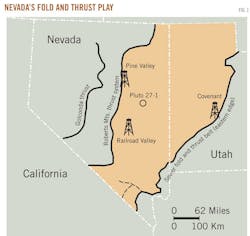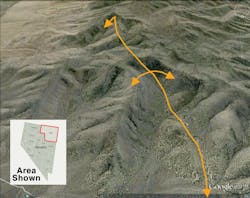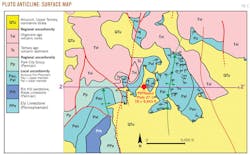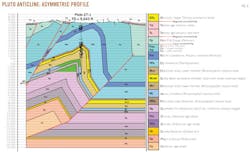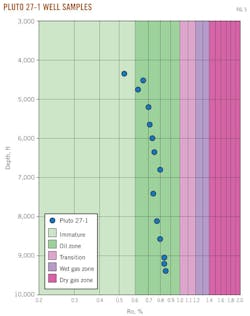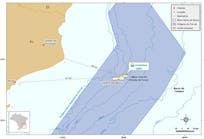Nevada's Chainman shale shows exploration potential
Thomas L. Davis
Geologist
Ventura, Calif.
Jay Namson
Namson Consulting Inc.
San Clemente, Calif.
The fold and thrust belt play that extends through eastern Nevada and western Utah remains largely underexplored (Fig. 1). Given its enormous area, there is potential for a subset of the fold and thrust belt play that includes surface anticlines of eastern Nevada.
In 2004, discovery of the 20-million-bbl Covenant oil field in central Utah initiated intense exploration efforts in the region (OGJ, Jan. 17, 2005). This was followed in 2008 by discovery of the smaller Providence oil field along the eastern edge of the belt in central Utah.1 Exploration activity has not extended to the broad interior of the belt, much of which lies in eastern Nevada.
For the purposes of this article, all hydrocarbon traps developed in the Cordilleran orogen and during the period from late Devonian to early Tertiary belong to the fold and thrust belt play.2 Tectonic events include:
• Late Devonian to early Mississippian Antler orogeny.3 4
• An unnamed orogenic event of middle Mississippian to late Permian age.5
• Triassic to middle Cretaceous structures of the central Nevada thrust belt.6
• Middle Jurassic Elko orogeny.7
• Late Jurassic to early Tertiary Sevier fold and thrust belt.8
In addition, the Permian to early Triassic Sonoma orogeny is generally confined to western Nevada although coeval structures are recorded in eastern Nevada.4 5 9
Historical exploration
The fold and thrust belt play and graben play in Nevada have undergone oil and gas exploration since the 1940s. In 1954 Shell Oil Co. discovered Eagle Springs oil field in Railroad Valley that became the first significant commercial find in the state.10 Oil from Railroad Valley and the surrounding area came from early Tertiary lacustrine beds buried deep in basin and range grabens.
Oil was generated from Miocene to present, trapped by fault blocks and unconformities developed during basin and range extension, and stored in Tertiary volcanic and sedimentary rocks.11
In the early 1980s, the graben play had expanded through eastern Nevada with the realization that the organic-rich beds of the Mississippian Chainman shale are an excellent source rock and the dolomitic beds of the Devonian Guilmette formation and Simonson Dolomite can be excellent reservoir units. By 1984 a dolomitic reservoir at Grant Canyon oil field in Railroad Valley was flowing 5,000-6,500 bo/d predominantly from two wells.12
Knowledge gained from the graben play is important for future exploration, but it also shows that a fault-block trap type of play can be small in closure and recoverable oil (generally less than 300 acres and 25 million bbl of oil). Despite moderate graben play exploration, only one other small producing area was discovered in Nevada's Pine Valley (5.5 million bbl of oil).
A third play is now developing in Nevada. The Chainman shale has aspects of both a resource play and a conventional fractured-shale play. The resource is an organic-rich shale of either Mississippian or early Tertiary age, or both (OGJ, Dec. 3, 2012, p. 42). It is unclear at this time if the conventional aspects of this play involve fold and thrust belt structures.
Petroleum system
Eastern Nevada lies within the scope of the US Geological Survey's (USGS's) Paleozoic-Tertiary Composite Total Petroleum System (PTPS) that provides a framework for prospect evaluation and indicates traps have oil and gas potential if they:
• Lie within the favorable Chainman shale source-rock trend.
• Predate hydrocarbon generation.
• Lie within the favorable Devonian carbonate reservoir trends of the Guilmette formation and Simonson dolomite.
• Have a reservoir seal.
Deeper source rock potential may exist in the Mississippian Joana limestone and late Devonian Pilot shale. Secondary reservoir targets are fractured and vuggy limestone beds of the Joana limestone, and clastic beds of the Scotty Wash sandstone member of the Chainman shale and Diamond Peak formation.13-16
Although exploration is limited, well results show that the fine-grained beds of the Chainman shale can be an effective seal for hydrocarbons. According to basin modeling studies, the Chainman shale experienced hydrocarbon generation from late Paleozoic to middle Jurassic and more localized generation from Miocene to present due to basin and range extension and burial within associated grabens.13 15 17 18
This younger phase of burial and generation, from Mississippian and early Tertiary source rocks, supplied the accumulations of oil trapped at Railroad and Pine Valleys.13 15 It is probable that many of the numerous traps associated with the older fold and thrust belt events (late Devonian through middle Jurassic) were well positioned to receive the older phase of hydrocarbon generation that was widespread. Many of these traps, however, no longer exist due to deep erosion, numerous phases of faulting and folding, basin and range extension, and metamorphism in places.
Alternatively, structures of the younger fold and thrust belt events (late Jurassic through early Tertiary) postdate the older hydrocarbon generation phase, which can pose an increased exploration risk with trap formation postdating hydrocarbon migration. These structures also require charge from the younger phase of oil generation that is more spatially constrained.
In eastern Nevada are extensive areas of the fold and thrust belt that are exposed between the basin and range grabens, where only upper Paleozoic rocks are exposed at the surface and folded into large anticlines.9 19 Fig. 2 is an image of one such anticline at the north end of Spruce Mountain in Elko County. Field surveys in northeast Nevada revealed several large surface anticlines that are suitable for test wells. According to constraints imposed by the previously mentioned USGS's PTPS plus the following trap specific requirements, exploration-prone anticlines will:
• Have four-way closure.
• Are free of complex faulting.
• Have sufficient sealing capabilities above the reservoir targets (Chainman shale not exposed on crest).
• Have closure at the reservoir target that is large enough to make the prospect commercially viable (greater than 1,000 acres).
Surface anticlines that meet these criteria and are of late Paleozoic to middle Jurassic age are more favorably located in time to trap early generated oil and gas. These older structures are difficult to determine, however, due to eastern Nevada's widespread stratigraphic hiatus between upper Paleozoic strata and mid-Tertiary volcanic rocks.
Pluto anticline potential
In 2007, Plains Exploration & Production Co., on a farmout from Gasco Energy Inc., drilled the Pluto 27-1 well on a surface anticline along US 50 west of Ely, Nev. (Fig. 1). The 27-1 well was not commercial and did not reach the reservoir targets; Plains left the play in 2008.
The anticline, informally called Pluto, is not visible from the air or roadside because the surface geology is masked by vegetation and the surface rocks do not make prominent outcrops.
Surface mapping shows the anticline has the Permian Arcturus formation along the axis, an asymmetric profile with a steep to vertical east limb, and is four-way closed. The anticline was known before our mapping, but the Pluto 27-1 was the first well drilled on this prospect (Figs. 3, 4).20
Plains drilled the 27-1 test based on surface mapping, cross-sections, and subsurface mapping between cross-section lines. Usable seismic images are difficult to obtain where Paleozoic rocks are at the surface, and there were other questions about the petroleum system that only drilling could address.21
The youngest strata folded in the anticline belong to the Permian Park City Group, and the anticline is unconformably overlain by unfolded volcanic beds of Oligocene age, indicating the anticline developed during the span from late Permian to early Tertiary time.22
The 27-1 well spudded in the Arcturus formation, entered the Chainman shale at 4,200 ft, and at 4,460 ft, and upon entering a 60-ft thick, quartz-rich sand, took a significant gas kick that recorded 377,000-ppm methane. An upright flare was installed that would jet 10-15 ft high and continued to flare through drilling of the well.
Spotty, light- to dark-brown oil-staining and yellow-gold fluorescence were observed in about 50% of the Chainman cuttings that consisted of thinly bedded, fine-grained sandstone and black shale. It is noteworthy that the 27-1 well showed that less than 200 ft of uppermost Chainman shale provides an effective seal for retaining gas and oil.
Dip meter results matched the surface dips, proving the well drilled the moderately dipping west limb of the anticline to about 4,300 ft and the crestal area from 4,300 to 6,700 ft. Due to hole problems, the operator failed to obtain deeper dip meter recordings.
Below 4,460 ft the mixed sand and shale lithology is characteristic of the Scotty Wash member of the Chainman shale, and the well remained in Chainman shale lithology to total depth (9,643 ft).
Chainman shale thickness in this area is known to range 1,600-2,400 ft; yet the 27-1 well drilled more than 5,300 ft of Chainman shale.16 The simplest interpretation of the two to three times normal thickness of Chainman shale is that at about 6,700 ft the well entered the steep limb of the anticline that is documented in the surface geology and remained in the steep limb to total depth.
Source rocks
What are the possible sources and timing of entrapment of oil and gas at the Pluto anticline? Miocene to present generation and migration from the Chainman shale buried in a basin and range graben to the Pluto anticline does not seem likely because it would require long-range migration across large, graben-margin normal faults.
Deeply buried Chainman shale local to the 27-1 well is a more likely source, and analysis of 14 Chainman samples from the well show that the well drilled a fairly typical, organic-rich Chainman shale section.23 Total organic carbon (TOC) from the samples ranged 0.90-2.43% with an average of 1.37%, and the highest TOCs are from the top of the Chainman where the best oil and gas shows occurred.
Samples have an equal abundance of Type II and III kerogen, and original TOCs are estimated to average 1.72% and to be 3.5% near the top of Chainman. Maturity samples from the 27-1 well are within the oil-generation window and show an unusually low increase in maturity with depth that is the result of drilling a steep fold limb (0.53 to 0.85% Ro, a 0.3% Ro increase over a 5,000 ft depth interval); (Fig. 5).
The Pluto anticline cross-section shows 16,000 ft of burial on basal Chainman in the syncline east of the Pluto anticline. Uncertainty in the local thickness of the Permian Park City Group and uppermost Arcturus formation, however, constrain the maximum burial of the base of the Chainman from 9,000 to 16,000 ft (Fig. 3).
Regardless, comparison of overburden thickness with published geohistory models suggests the Pluto location entered the oil window at the end of the Permian.15 Hydrocarbons trapped at the Pluto anticline are most likely due to folding beginning during the Permian and hydrocarbon entrapment from that time until the middle Jurassic.
A local unconformity between the Arcturus and Park City Group confirms folding during the Permian and could be the result of convergence from an unnamed middle Mississippian to late Permian event (Fig. 4).5
Further exploration
The 27-1 well shows there is exploration potential in the surface anticlines of eastern Nevada, which broadens the plays in the USGS's PTPS in eastern Nevada and possibly western Utah.15
Despite the well's failure to discover commercial hydrocarbons, the Pluto anticline remains a viable prospect for a sidetrack because the reservoir target was not reached. Based on the well's results, the Chainman shale appears to be an effective seal for hydrocarbons. The anticline traps hydrocarbons in the shallower secondary reservoir targets, and it predates both episodes of oil generation.
Hydrocarbon-bearing fold belts are never fully evaluated until a number of the large, unbreached surface anticlines are tested through the known reservoir targets. Based on this principle, eastern Nevada's fold and thrust belt remains largely unevaluated.
References
1. Chidsey, Jr., T.C., Hartwick, E., Johnson, K.R., Schelling, D., Sbarra, R., Sprinkel, D.A.,Vrona, J.P., and Wavrek, D.A., "Petroleum Geology of Providence Oil Field, Central Utah Thrust Belt," AAPG Search and Discovery Article No. 90142, AAPG Annual Convention and Exhibition, Apr. 22-25, 2012, Long Beach, Calif.
2. Burchfiel, B.C., Cowan, D.S., and Davis, G.A., "Tectonic overview of the Cordilleran orogen in the western United States," in Burchfiel, B.C., Lipman, P.W., and Zoback, M.L., "The Cordilleran Orogen: Conterminous US," Geological Society of America, Vol. G-3, 1992, Chapter 8, pp. 407-480.
3. Roberts, R.J., Hotz, P.E., Gilluly, J., and Ferguson, H.G., "Paleozoic rocks of north-central Nevada," AAPG Bull. 42, 1958, pp. 2813-2857.
4. Silberling, N.J., and Roberts, R.J., "Pre-Tertiary Stratigraphy and Structure of Northwestern Nevada," Geological Society of America, GSA Special Paper 72, 1962, pp. 58.
5. Cashman, P., Trexler, J.H., Synder, W., Davydov, V., and Taylor, W., "Late Paleozoic deformation in central and southern Nevada," in Duebendorfer, Ernest, and Smith, Eugene, eds., Field Guide to Plutons, Volcanoes, Faults, Reefs, Dinosaurs, and Possible Glaciation in Selected Areas of Arizona, California, and Nevada, GSA Field Guide 11, 2008, pp. 21-42.
6. Taylor, W., "Mesozoic thrusting in the hinterland of the Sevier orogenic belt: The central Nevada thrust belt," Geological Society of America 2001 Annual Meeting Abstracts.
7. Thorman, C.H., and Peterson, F., "The Middle Jurassic Elko Orogeny-A Major Tectonic Event in Nevada-Utah," AAPG Search and Discovery article, No. 30022, 2004, adapted from "extended abstract" for presentation at the AAPG Annual Meeting, Salt Lake City, May 11-14, 2003.
8. Armstrong R.L., "Sevier Orogenic Belt in Nevada and Utah," GSA Bull. Vol. 79, No. 4, 1968, pp. 429-458.
9. Coats, R.R., "Geology of Elko County, Nevada," Nevada Bureau of Mines and Geology Bull. Vol. 101, 1987, p. 112.
10. Garside, L.J., Hess, R.H., Fleming, K.L., and Weimer, B.S., "Oil and Gas Developments in Nevada," Nevada Bureau of Mines and Geology Bull. 104, 1988, pp. 136.
11. French, D.E., "History of Oil Exploration in the Great Basin," in French, D.E., and Schalla, R.A., eds., "Hydrocarbon Habitat and Special Problems of the Great Basin," Nevada Petroleum Society 1998 Field Trip Guide, 1998a, pp. 8-10.
12. French, D.E., "Petroleum geology of Bacon Flat and Grant Canyon fields," in French, D.E., and Schalla, R.A., eds., "Hydrocarbon Habitat and Special Problems of the Great Basin," Nevada Petroleum Society 1998 Field Trip Guide, 1998b, pp. 68-70.
13. Poole, F.G., and Claypool, G.E., "Petroleum source-rock potential and crude-oil correlation in the Great Basin," in Woodward, J., Meissner, F.F., and Clayton, J.L., eds., "Hydrocarbon source rocks of the Greater Rocky Mountain region," Rocky Mountain Association of Geologists, 1984, pp. 179-229.
14. Read, D.L., and Zogg, W.D., "Description and origin of the Devonian dolomite oil reservoir, Grant Canyon field, Nye County, Nevada," in Goolsby, S.M., and Longman, M.W., eds., Occurrence and petrolphysical properties of carbonate reservoirs in the Rocky Mountain region, Rocky Mountain Association of Geologists, 1988, pp. 229-240.
15. Anna, L.O., Roberts, L.N.R., and Potter, C.J., "Geologic Assessment of Undiscovered Oil and Gas in the Paleozoic–Tertiary Composite Total Petroleum System of the Eastern Great Basin, Nevada and Utah," in Geologic Assessment of Undiscovered Oil and Gas Resources of the Eastern Great Basin Province: Nevada, Utah, Idaho, and Arizona, Chapter 2, 2007, USGS Digital Data Series DDS-69-L.
16. Trexler, Jr., J.H., Snyder, W., Schwartz, D., Kurka, M., and Crosbie, R., "An overview of the Mississippian Chainman Shale," in Hansen, M.W., Walker, J.P., and Trexler, Jr., J.H., eds., Mississippian Source Rocks in the Antler Basin of Nevada and Associated Structural Traps, Nevada Petroleum Society, 1995, p. 45-60.
17. Inan, S., and Davis, A., "The history of oil generation in Pine and Railroad Valleys, eastern Nevada," in Schalla, R.A., and Johnson, E.H., eds., Oil Fields of the Great Basin, Nevada Petroleum Society, 1994, p. 57-84.
18. Barker, C.E., and Peterson, J.A., "Burial history of the Mississippian Chainman Shale and Eocene Sheep Pass Formation, Railroad, and White River Valleys, eastern Nevada," in Flanigan, D.M.H., Hansen, M., and Flanigan,T.E., eds., Geology of the White River Valley, the Grant Range, Eastern Railroad Valley, and Western Egan Range, Nevada, Nevada Petroleum Society, 1991 Fieldtrip Guidebook, pp. 70.
19. Hose, R.K., and Blake, Jr., M.C., "Geology and Mineral Resources of White Pine County, Nevada," Nevada Bureau of Mines and Geology Bull. No. 85, p. 105.
20. Poole, F.G., Thorman, C., and Howard, E.L., "Road log from Ely to Garden Pass via Ruth Pit, Moorman Ranch, and Eureka with extensions to Bruffey Seep and Devil's Gate," in Newman, G.W. and Goode, H.D., eds., Basin and Range Symposium, Rocky Mountain Association of Geologists and Utah Geological Association, 1979, pp. 621-636.
21. Johnson E.H., "Using Seismic, gravity, and magnetic data to explore for oil in the Great Basin," in Schalla, R.A. and Johnson, E.H., eds., "Oil Fields of the Great Basin," Nevada Petroleum Society, 1994, pp. 115-120.
22. Feeley, T.C., "Geologic map of the Robinson Summit Quadrangle, Nevada," Nevada Bureau of Mines and Geology Field Studies, 1993, Map 2.
23. Ruble, T.E., and Jarvie, D.M., "Executive report, source rock geochemistry of the Pluto 27-1 well, White Pine County, Nevada," unpublished Humble Geochemical Services Division, 2007.
The authors
Thomas L. Davis ([email protected]) is president at Pleito Oil & Gas Co., Ventura, Calif. He has also served as consulting geologist for ARCO Exploration and International Co. and Davis and Namson Consulting. He holds a BS and PhD in geology from the University of California.
Jay Namson ([email protected]) is a consultant specializing in structurally complex areas. He has also served as research geologist for ARCO Research and Namson Consulting Inc. He holds a PhD in geology from Princeton University.
